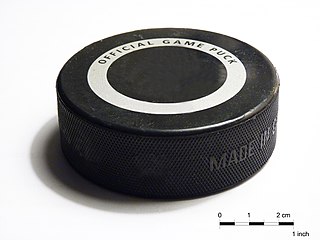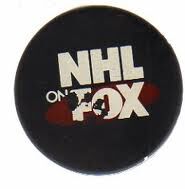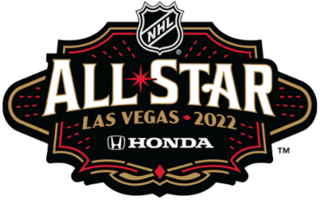Related Research Articles

A hockey puck is either an open or closed disk used in a variety of sports and games more notably ice hockey. There are designs made for use on an ice surface, such as in ice hockey, and others for the different variants of floor hockey which includes the wheeled skate variant of inline hockey. They are all designed to serve the same function a ball does in ball games.

The NHL on Fox is the branding used for broadcasts of National Hockey League (NHL) games that were produced by Fox Sports and televised on the Fox network from the 1994–1995 NHL season until the 1998–1999 NHL season. NHL games continued to air on the Fox Sports Networks in the form of regional game telecasts until the 2021 rebrand to Bally Sports. As of 2024, only one Fox station airs hockey broadcasts.

The NHL on NBC was an American presentation of National Hockey League (NHL) games produced by NBC Sports, and televised on NBC properties, including MSNBC, CNBC, Golf Channel, USA Network and NBCSN in the United States.

1st & Ten is a computer system that augments televised coverage of American football by inserting graphical elements on the field of play as if they were physically present; the inserted element stays fixed within the coordinates of the playing field and obeys the visual rules of foreground objects occluding background objects. Developed by Sportvision and PVI Virtual Media Services, it is best known for generating and displaying a yellow first down line over a live broadcast of a football game—making it easier for viewers to follow play on the field. The line is not physically present on the field and is seen only by the television audience.
Sportvision was a private company, launched in January 1998, that provided various television viewing enhancements to a number of different professional sporting events. They worked with NFL, NBA, NASCAR, NHL, MLB, PGA and college football broadcasts. Sportvision was co-founded by CEO Bill Squadron, CTO Stan Honey and COO Jerry Gepner, who had all worked together at Fox Sports and its parent company, News Corporation.

The 1996 National Hockey League All-Star Game took place at the FleetCenter in Boston on January 20, 1996. The 46th game was originally scheduled to take place in 1995, but the lockout of the 1994–95 NHL season led to its postponement.

The broadcasts of National Hockey League (NHL) games produced by ESPN have been shown on its various platforms in the United States, including ESPN itself, ABC, ESPN+, ESPN2, ESPNEWS, ESPNU, and Hulu. Since 2021, games have been broadcast under the ESPN Hockey Night branding, while those on ESPN+ have used the ESPN+ Hockey Night branding.
The National Hockey League has never fared as well on American television in comparison to the National Basketball Association, Major League Baseball, or the National Football League, although that has begun to change, with NBC's broadcasts of the final games of the 2009, 2010, 2011, and 2013 Stanley Cup Finals scoring some of the best ratings ever enjoyed by the sport on American television.
Justin Bourne is an American sportswriter. A former professional ice hockey player, he has also coached professionally, most recently as an assistant coach for the Toronto Marlies of the American Hockey League.
Virtual advertising is the use of digital technology to insert virtual advertising content into a live or pre-recorded television show, often in sports events. This technique is often used to allow broadcasters to overlay existing physical advertising panels with virtual content on the screen when broadcasting the same event in multiple regions; a Spanish football game will be broadcast in Mexico with Mexican advertising images. Similarly, virtual content can be inserted onto empty space within the sports venue such as the field of play, where physical advertising cannot be placed due to regulatory or safety reasons. Virtual advertising content is intended to be photo-realistic, so that the viewer has the impression they are seeing the real in-stadium advertising.

NHL on Sportsnet is the blanket title for presentations of the National Hockey League broadcast held by a Canadian media corporation, Rogers Communications, showing on its television channel Sportsnet and other networks owned by or affiliated with its Rogers Media division, as well as the Sportsnet Radio chain. Sportsnet previously held the national cable rights for NHL regular season and playoff games from 1998 to 2002. In November 2013, Rogers reached a 12-year deal to become the exclusive national television and digital rightsholder for the NHL in Canada, beating out both CBC Sports and TSN.

The 2015 NHL Winter Classic was an outdoor ice hockey game played in the National Hockey League (NHL) on January 1, 2015, at Nationals Park in Washington, D.C. The seventh edition of the Winter Classic, it matched the Chicago Blackhawks against the Washington Capitals. The Capitals won, 3–2, after right winger Troy Brouwer scored the go-ahead goal with less than 13 seconds remaining in regulation play. This marked the first time in Winter Classic history that the home team won in regulation. The game garnered an attendance of 42,832, and was televised nationally in the United States on NBC and in Canada on CBC.
Greg Wyshynski is an American sportswriter and radio personality, best known for creating Yahoo! Sports’ ice hockey blog Puck Daddy. He has written two books, Glow Pucks and 10-Cent Beer and Take Your Eye Off the Puck.

The 2019 National Hockey League All-Star Game was held at SAP Center in San Jose, home of the San Jose Sharks on January 26, 2019. San Jose last held the NHL All Star Game in 1997. This was the fourth consecutive All-Star Game that used a four-team, 3-on-3, single elimination format, with one team representing each of the league's four divisions. After years of being held on a Sunday, the 2019 All-Star Game was played on a Saturday, January 26, at 5 p.m. PST/8 p.m. EST, while the Skills Competition was also moved from its traditional Saturday night to Friday, January 25, 2019.

The 2020 National Hockey League All-Star Game was held on January 25, 2020, at the Enterprise Center in St. Louis, Missouri, the home of the St. Louis Blues. The city previously hosted the NHL All-Star Game in 1970 and 1988 at the former St. Louis Arena. For the fifth year, the All-Star Game used a 3-on-3 format, with teams representing each of the league's four divisions competing in a single-elimination tournament.
The 2019–20 NHL season was the 103rd season of operation of the National Hockey League. The regular season began on October 2, 2019, with playoffs originally planned for April and the Stanley Cup Finals planned for June. The season was suspended indefinitely on March 12, 2020, due to the COVID-19 pandemic.

The 2022 National Hockey League All-Star Game was held on February 5, 2022, at T-Mobile Arena in Paradise, Nevada, the home of the Vegas Golden Knights. For the sixth consecutive All-Star Game, a three-on-three format was used, with teams representing each of the league's four divisions competing in a single-elimination tournament.

Scotiabank Wednesday Night Hockey is the branding used for Sportsnet’s flagship broadcasts of National Hockey League games on Wednesday nights. In November 2013, Rogers reached a 12-year deal to become the exclusive national television and digital rightsholder for the NHL in Canada, beating out broadcasters CBC Sports and TSN for the rights.
A digitally enhanced dasherboard (DED) is a virtual advertising product offered by the National Hockey League (NHL) for television broadcasts of ice hockey games. DEDs erase and replace the local ads painted on dasher boards that surround hockey rinks with a sequence of static and animated advertisements on each television broadcaster.
References
- ↑ "Tracking the Ice Hockey Puck - FoxTrax (Glow Puck)". Engineering and Technology History Wiki. 6 January 2015. Retrieved 2016-01-26.
- 1 2 3 4 5 Brown, Aaron (28 January 2014). "Lame Puck: Was Fox's glowing puck the worst blunder in TV sports history, or was it just ahead of its time?". Slate. Retrieved 5 March 2017.
- ↑ Rick Cavallaro. "First-Hand:Recollections of the development of the FoxTrax hockey puck tracking system". IEEE Global History Network. Retrieved 2013-10-28.
- 1 2 Hirsley, Michael. "Fox's Techno-puck Makes Hawks' Menu". Chicago Tribune. Retrieved 5 March 2017.
- 1 2 "Bring back the glow puck; no, I'm serious". ESPN.com. Retrieved 2017-10-21.
- ↑ "Worst sports innovations". 2002-07-17. Retrieved 2013-10-23.
- ↑ Keri, Jonah (2006-11-30). "Gear through the years". ESPN. Retrieved 2008-03-20.
- ↑ Cavallaro, R. (1997). "The FoxTrax hockey puck tracking system". IEEE Computer Graphics and Applications. 17 (2): 6–12. doi:10.1109/38.574652. ISSN 0272-1716.
- ↑ Costa, Brandon (26 January 2019). "In NBC Sports' NHL All-Star Game Production, Player/Puck Tracking Is the Belle of the Ball". Sports Video Group. Retrieved January 27, 2019.
- ↑ Thomas, Ian. "NBC Sports readies new moves for NHL All-Star Game". New York Business Journal. Retrieved January 27, 2019.
- ↑ Hornick, Matt (January 25, 2019). "Gary Bettman announces puck, player tracking for 2019-20 NHL season". Sporting News. Retrieved January 27, 2019.
- ↑ Dachman, Jason (January 13, 2021). "NHL Puck Drop 2021: NBC Sports Will Be Onsite for Exclusive Games But Will Lean Heavily on RSNs, Stamford Broadcast Center". Sports Video Group. Archived from the original on January 27, 2021. Retrieved January 31, 2021.
- ↑ Dachman, Jason (January 13, 2021). "NHL Puck Drop 2021: Sportsnet Looks To Limit Travel, Enhance Safety, Maintain Quality". Sports Video Group. Archived from the original on January 26, 2021. Retrieved January 31, 2021.